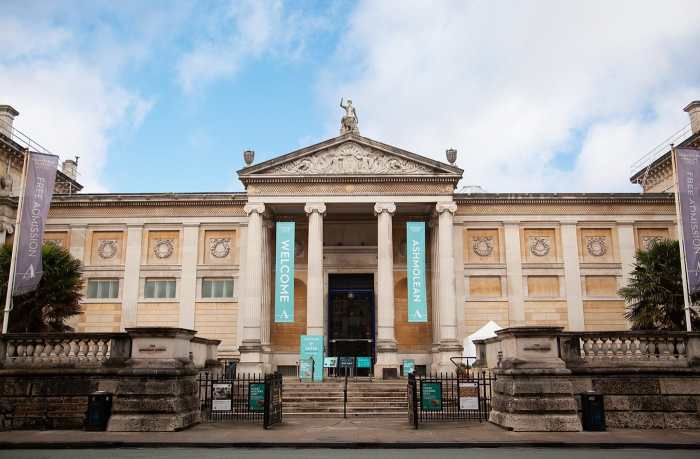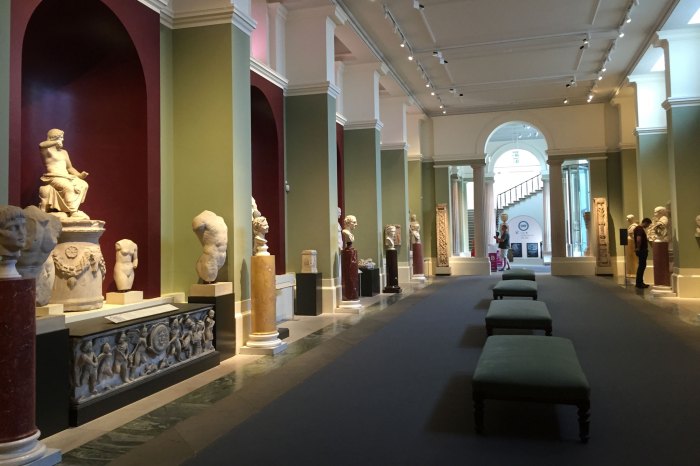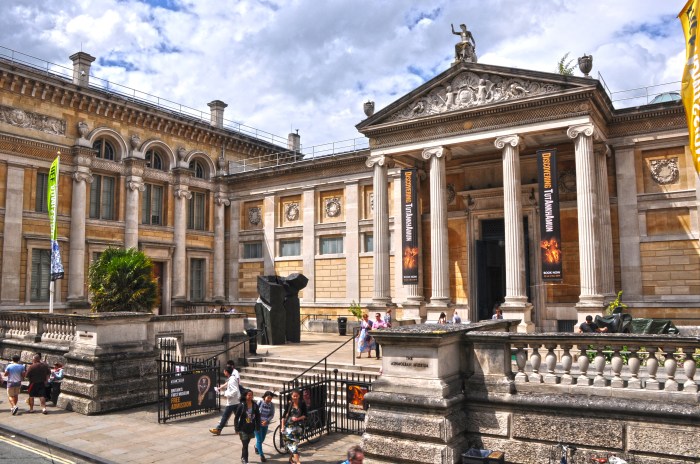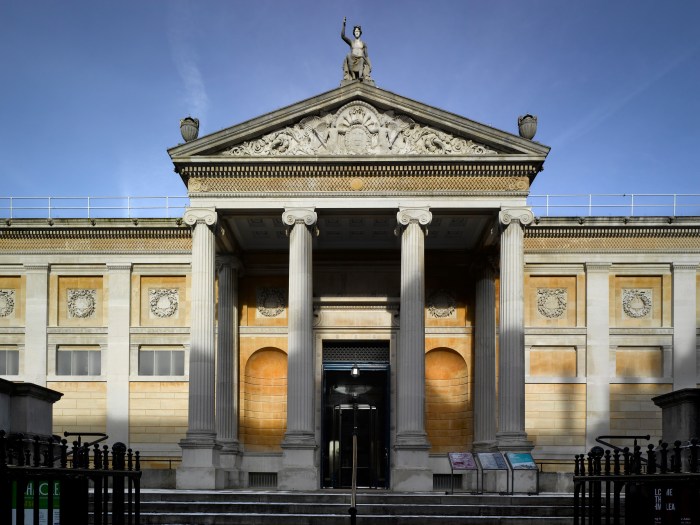Nestled in the heart of Oxford, the Ashmolean Museum stands as a testament to the enduring power of art and culture. Founded in 1683, it boasts a remarkable collection spanning centuries and civilizations, offering visitors a captivating journey through the annals of human creativity.
From ancient Egyptian artifacts to masterpieces by Renaissance masters, the Ashmolean’s diverse holdings reflect the breadth and depth of human artistic expression. Its galleries invite exploration, each revealing a unique perspective on the human experience.
History and Background

The Ashmolean Museum, a cornerstone of Oxford University, traces its roots back to 1683 when Elias Ashmole, an antiquarian and collector, bequeathed his vast collection of curiosities and artifacts to the university. This assemblage, comprising ancient coins, sculptures, and natural specimens, laid the foundation for the museum’s remarkable journey.
Over the centuries, the Ashmolean Museum has undergone significant growth and expansion. In 1845, the university acquired the Arundel Marbles, a collection of ancient Greek sculptures that further enriched the museum’s holdings. The establishment of the Department of Fine Art in 1939 marked another milestone, as it brought together the museum’s art collections under one roof.
Notable Acquisitions
- 1855: The museum acquired the collection of Sir John Soane, an architect and collector, which included architectural drawings, paintings, and sculptures.
- 1947: The museum received the bequest of the art collection of Sir Michael Sadler, a former Vice-Chancellor of Oxford University, which included works by Rembrandt, Constable, and Turner.
- 2001: The museum acquired the Waddesdon Bequest, a collection of French decorative arts and furniture from the 18th century, which transformed the museum’s holdings in this area.
Collection Highlights

The Ashmolean Museum houses a vast and diverse collection of art and artifacts, spanning various periods and cultures. Its collection is organized into several distinct categories, each offering a unique glimpse into the artistic and historical significance of the objects it contains.
Among the most notable highlights of the collection are the following:
Paintings, Ashmolean museum
The Ashmolean Museum boasts an impressive collection of paintings, ranging from Old Masters to contemporary works. Notable pieces include:
- The Virgin and Child with Saint John the Baptist by Raphael
- Venus and Cupid by Titian
- The Hay Wain by John Constable
- Water Lilies and Japanese Bridge by Claude Monet
Sculptures
The museum’s sculpture collection encompasses a wide range of materials and styles, from ancient Egyptian statues to modern bronze works. Highlights include:
- The Venus de Milo, a marble statue from ancient Greece
- The Dying Gaul, a Roman bronze sculpture
- David by Michelangelo, a marble sculpture from the Renaissance
- The Thinker by Auguste Rodin, a bronze sculpture from the 19th century
Antiquities
The Ashmolean Museum houses a significant collection of antiquities, including artifacts from ancient Egypt, Greece, and Rome. Notable pieces include:
- The Rosetta Stone, a fragment of an ancient Egyptian decree that played a key role in deciphering hieroglyphics
- The Elgin Marbles, a collection of sculptures from the Parthenon in Athens
- The Portland Vase, a Roman glass cameo vase
- The Alfred Jewel, an Anglo-Saxon gold and enamel ornament
Other Highlights
In addition to the categories mentioned above, the Ashmolean Museum also houses significant collections of drawings, prints, coins, and medals. These collections offer a comprehensive overview of the development of art and design throughout history.
Exhibitions and Displays
The Ashmolean Museum takes a multifaceted approach to curating and presenting exhibitions, aiming to engage visitors and foster appreciation for art. Exhibitions are meticulously planned to explore diverse themes, concepts, and narratives, showcasing the museum’s extensive collection in innovative and thought-provoking ways.
Exhibition Themes and Concepts
Recent exhibitions have delved into themes such as the influence of ancient Egypt on Western art, the relationship between art and science, and the evolution of artistic techniques over time. Upcoming exhibitions promise to explore topics such as the history of photography, the impact of social media on art, and the role of museums in society.
Visitor Engagement and Appreciation
The museum employs various strategies to engage visitors and foster appreciation for art. Interactive displays, multimedia presentations, and guided tours enhance the visitor experience, providing insights into the artworks and their historical and cultural contexts. Educational programs, workshops, and lectures offer opportunities for deeper engagement with art and the museum’s collection.
Educational Programs and Outreach

The Ashmolean Museum actively promotes art education and fosters creativity through a comprehensive range of educational initiatives.
These programs cater to diverse audiences, including students, educators, and the general public, aiming to inspire, engage, and deepen understanding of art and its historical significance.
Guided Tours
The museum offers guided tours led by knowledgeable docents who provide insights into the collection’s masterpieces and the stories behind them. These tours are tailored to specific themes or interests, catering to both casual visitors and those seeking in-depth exploration.
Workshops
The Ashmolean Museum hosts workshops that offer hands-on experiences related to art and its techniques. Participants engage in creative activities, learning from professional artists and educators while developing their own artistic skills.
Lectures and Talks
The museum organizes lectures and talks by renowned scholars, artists, and curators. These events provide a platform for discussing current research, artistic trends, and the broader context of art history.
Architectural Significance
The Ashmolean Museum is housed in a magnificent building that is itself a work of art. The museum’s architecture has evolved over time, reflecting the changing needs of the institution and the tastes of the day. The original building was designed by Sir Christopher Wren in the 17th century, and it featured a classical facade with a grand portico. In the 19th century, the museum was expanded by the addition of a new wing designed by C.R. Cockerell. This wing was built in the neo-Gothic style, and it features a soaring tower that dominates the museum’s skyline. In the 20th century, the museum was further expanded by the addition of a new wing designed by James Stirling. This wing is built in a modernist style, and it features a striking facade of glass and concrete.
The Ashmolean Museum’s architecture is a reflection of the museum’s long and distinguished history. The building has been adapted and expanded over time to accommodate the museum’s growing collection and to meet the changing needs of its visitors. The museum’s architecture is also a reflection of the changing tastes of the day. The classical facade of the original building reflects the prevailing architectural style of the 17th century, while the neo-Gothic wing reflects the popularity of this style in the 19th century. The modernist wing reflects the shift in architectural tastes that occurred in the 20th century.
Relationship between Architecture and Collection
The Ashmolean Museum’s architecture plays an important role in the display of the museum’s collection. The classical facade of the original building creates a sense of grandeur and authority, which is appropriate for a museum that houses a world-renowned collection of art and artifacts. The neo-Gothic wing provides a more intimate and atmospheric setting for the display of the museum’s collection of medieval art. The modernist wing provides a flexible and adaptable space for the display of the museum’s collection of contemporary art.
The Ashmolean Museum’s architecture is not only a reflection of the museum’s history and collection, but it is also a work of art in its own right. The building is a beautiful and inspiring space that enhances the visitor’s experience of the museum’s collection.
The Ashmolean Museum, a haven for art and history enthusiasts, is a must-visit for discerning travelers seeking cultural enrichment. For those planning a luxurious escape, luxury travel deals can elevate your experience, allowing you to indulge in the finer things in life while immersing yourself in the wonders of the Ashmolean Museum’s extraordinary collections.
Impact on Art and Culture

The Ashmolean Museum has played a significant role in shaping the art world and broader culture. Its vast and diverse collection has influenced artistic trends, preserved cultural heritage, and inspired future generations.
While visiting the Ashmolean Museum to admire its renowned art collection, it’s easy to forget the joys of a beach getaway. To prepare for your next seaside adventure, consider consulting beach holiday packing list. The museum’s serene ambiance may inspire you to pack light, leaving ample space for seashells and memories.
The museum’s collection includes masterpieces from various cultures and time periods, providing a comprehensive overview of human creativity. These works have served as inspiration for countless artists, who have drawn upon them for techniques, motifs, and ideas. The museum has also organized groundbreaking exhibitions that have showcased emerging artists and challenged conventional art historical narratives.
Preservation of Cultural Heritage
The Ashmolean Museum has played a crucial role in preserving cultural heritage. Its collection includes artifacts from civilizations around the world, many of which are unique and irreplaceable. By safeguarding these objects, the museum ensures that future generations can appreciate and learn from the artistic and cultural achievements of the past.
Inspiration for Future Generations
The Ashmolean Museum has been a source of inspiration for future generations of artists, scholars, and the general public. Its educational programs and outreach initiatives engage audiences of all ages, fostering a love of art and culture. The museum’s exhibitions and displays are designed to be accessible and engaging, making them a valuable resource for students, researchers, and art enthusiasts alike.
After visiting the Ashmolean Museum and admiring its vast collection of art and artifacts, you might be inspired to embark on an adventure of your own. For those seeking an adrenaline rush, extreme sports vacations offer the perfect opportunity to push your limits.
From bungee jumping to skydiving, these experiences will create unforgettable memories. But once you return to the tranquility of the Ashmolean Museum, you can appreciate the beauty of history and culture once again.
Examples of Influence
- The Ashmolean Museum’s collection of Pre-Raphaelite paintings has inspired generations of artists, including Dante Gabriel Rossetti and Edward Burne-Jones.
- The museum’s holdings of ancient Egyptian artifacts have informed the work of Egyptologists and archaeologists worldwide.
- The museum’s educational programs have fostered a lifelong passion for art and culture in countless individuals, including many who have gone on to become successful artists and scholars.
Ending Remarks

The Ashmolean Museum continues to evolve, adapting to the changing landscape of the art world while remaining steadfast in its commitment to preserving and showcasing artistic heritage. Its exhibitions, educational programs, and architectural grandeur ensure that it remains a vibrant and inspiring destination for art enthusiasts and scholars alike.
Clarifying Questions: Ashmolean Museum
When was the Ashmolean Museum founded?
1683
What is the significance of the Ashmolean’s collection?
It spans centuries and civilizations, showcasing the diversity of human artistic expression.
What types of exhibitions does the Ashmolean host?
Thematic, chronological, and special exhibitions exploring various aspects of art and culture.
What educational programs does the Ashmolean offer?
Guided tours, workshops, lectures, and outreach programs for all ages.